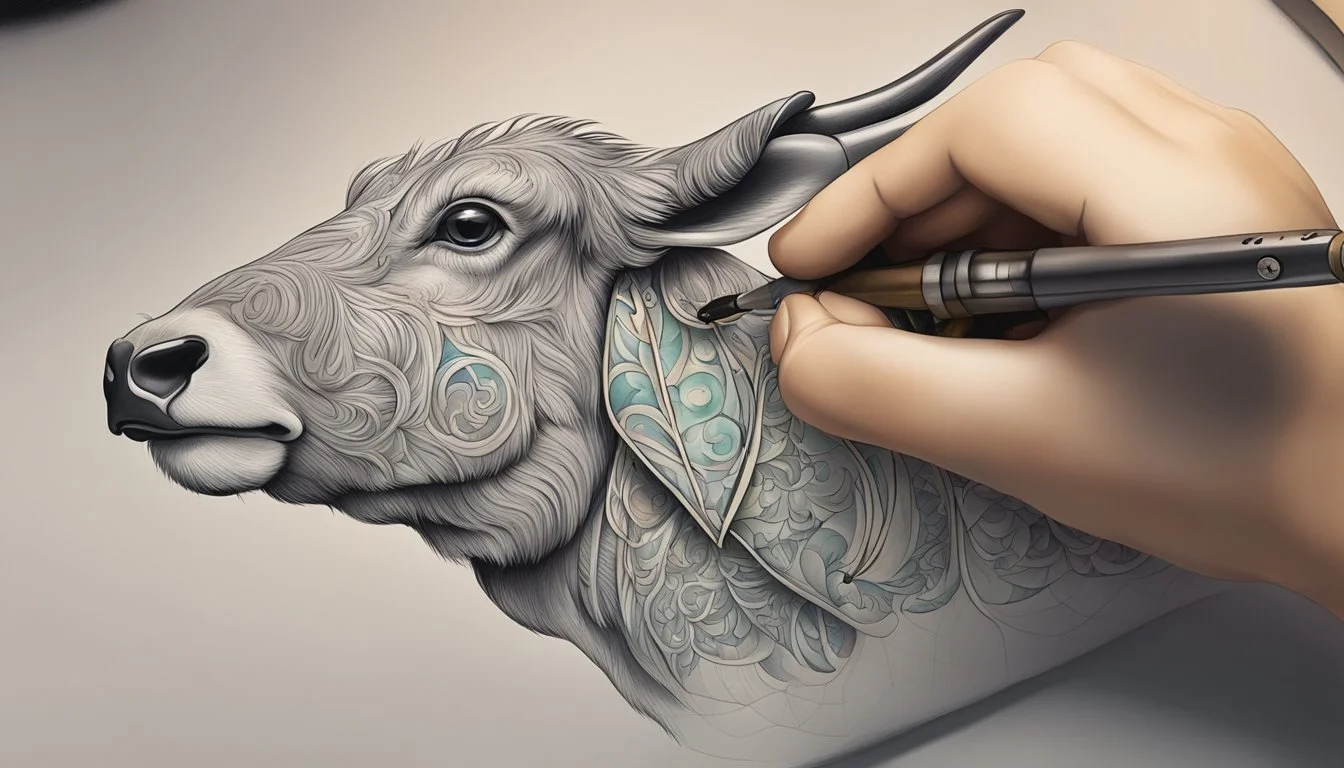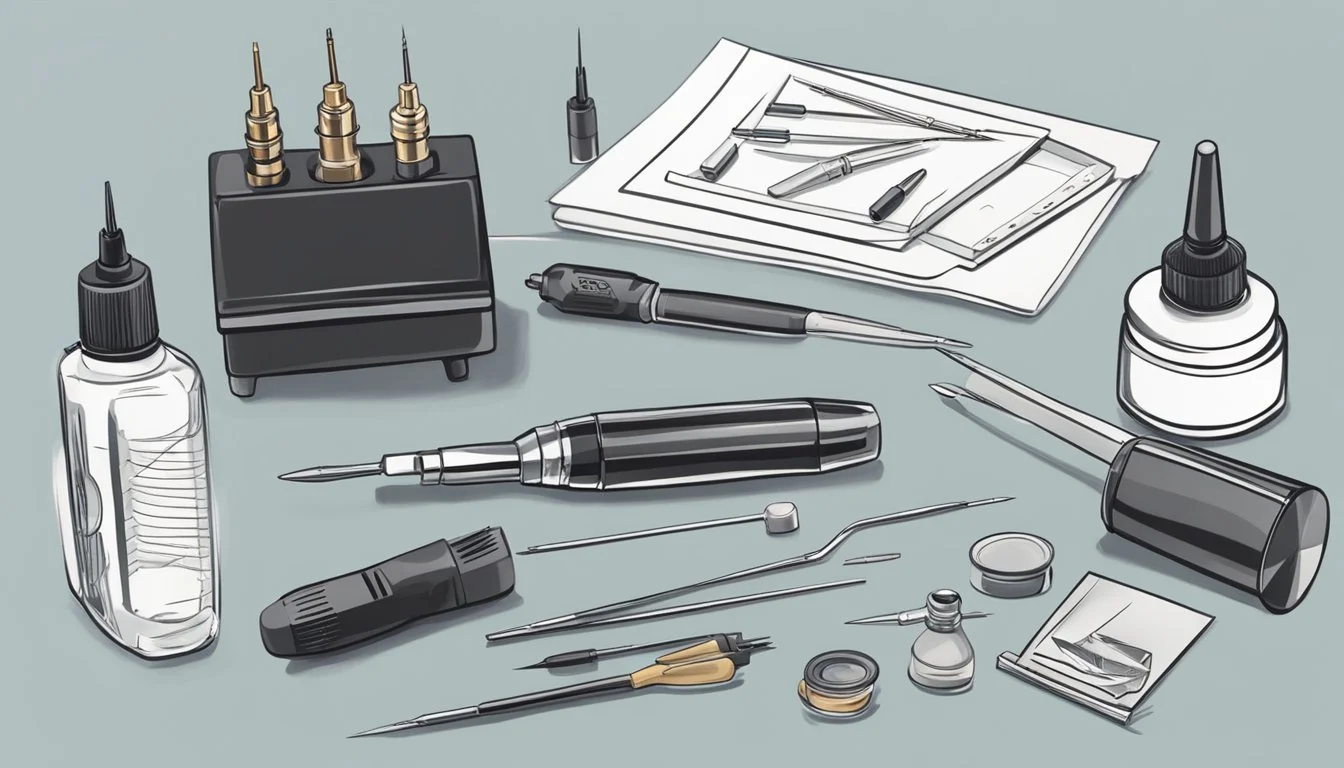The Ultimate Guide to Using a Livestock Tattoo Kit
Ensure Permanent Identification on Your Homestead
Permanent identification of livestock is a crucial aspect of farm management, ensuring traceability, ownership verification, and ease in managing herd records. Tattooing is a popular and effective method for permanently marking cattle, goats, and other livestock. The allure of using a livestock tattoo kit stems from its simplicity and permanence. Unlike ear tags, which can become lost or damaged, a tattoo endures as a fail-safe identification marker that remains with the animal for life.
To facilitate accurate and easy reading of tattoos, proper technique and cleanliness are paramount. Homesteaders and farmers need to understand the process, from preparing the animal's skin to maintaining the equipment. Adequate knowledge about the steps involved in tattooing ensures that the animals undergo minimal stress and reduces the risk of infection post-tattooing. Moreover, it is imperative for livestock owners to select the right tools and supplies to achieve legible and lasting results that meet regulatory needs and personal record-keeping.
Understanding Livestock Identification
Livestock identification is a critical part of managing a homestead's animal assets. It ensures that animals can be individually recognized for various reasons, ranging from health management to breeding programs.
History of Animal Identification
Animal identification has deep historical roots, tracing back to ancient times when livestock were marked with paint, tar, or physical tags to denote ownership. These initial methods evolved over time with advancements in agriculture technology. The introduction of branding in the ancient Egyptians' time, hot iron branding in the Romans' era, and modern methods such as ear tagging and tattooing illustrate the adaptation to more efficient and humane practices.
Importance of Permanent Identification
Permanent identification is crucial for the effective management of livestock. It is especially vital for:
Tracking lineage: Essential for breeding and maintaining genetic diversity.
Health management: Ensures that individual treatment records are accurately kept, allowing for better control of diseases.
Proof of ownership: Provides legal assurance during transactions and in case of disputes.
Regulatory compliance: Many regions require permanent identification for traceability in food supply chains.
Tattooing has become a favored method of permanent identification for many homesteaders because it is relatively easy to administer, durable, and does not require sophisticated equipment. Using a tattoo kit, an alphanumeric code is permanently marked on the animal, typically inside the ear, leaving a readable identifier after the ink dries and flakes away.
Overview of Livestock Tattoo Kits
Livestock tattoo kits are specialized tools designed for the permanent identification of animals. They are widely used for marking livestock, predominantly cattle, to facilitate management practices such as health monitoring, breeding, and record keeping.
Components of a Tattoo Kit
A livestock tattoo kit typically comprises several essential components:
Tattoo Pliers: These are the tool's handle and frame that enable the user to hold digits or letters firmly.
Digits and Letters: Sets of individual numbers and letters that can be inserted into the pliers to form unique identification codes.
Ink: Specialized tattoo ink is used to ensure the legibility and permanence of the tattoo, commonly available in green ink, which provides high contrast against the animal’s skin.
Ink Well or Pad: A container or surface for holding the tattoo ink before it is applied to the animal’s skin.
Cleaning Supplies: Materials such as alcohol for sanitizing the equipment between uses to prevent infections.
Types of Tattoo Kits
There are various types of livestock tattoo kits available, catering to different animal identification needs:
Standard Tattoo Kits: Contain basic components and are suitable for small-scale operations or individual animal tattooing.
Rotary Tattoo Kits: Designed for faster and more efficient tattooing, allowing for the quick change of digits and letters.
Custom Tattoo Kits: Can be tailored with specific digit and letter combinations as well as unique plier designs for specific ranch or farm requirements.
Preparation for Tattooing
Successful tattooing starts with meticulous preparation, ensuring that both the equipment and the animal are ready for the procedure. This preparation minimizes the risk of infection and enhances the legibility of the tattoo for accurate and permanent identification.
Preparing the Tattoo Equipment
Before tattooing, one must ensure the equipment is sterilized and functioning correctly. Cleanliness is crucial in this process to prevent infections, which can complicate the tattooing process and the healing afterward.
Sterilization: All parts of the tattoo kit, especially the pliers and needles, must be thoroughly sanitized. Submerge the equipment in a solution of rubbing alcohol for a period, following the manufacturer's recommendations.
Inspection: Check each needle for damage. Bent or dull needles can compromise the tattoo's clarity and cause unnecessary discomfort to the animal.
Ink Preparation: Confirm that the tattoo ink is of good quality, as poor ink can lead to illegible tattoos. If using a roll-on applicator, ensure it moves freely.
Animal Preparation Procedures
The individual performing the tattooing should ensure the animal is restrained adequately to prevent movements that could cause injury or a poorly applied tattoo.
Hair Removal: Trim the hair at the tattoo site for better visibility and to facilitate the ink entering the skin.
Cleaning the Site: With the hair removed, the ear should be cleaned thoroughly. Clean the ear with alcohol to disinfect the area, providing a clean surface for the tattoo.
Dry the Site: After cleaning, dry the area completely to ensure the ink adheres properly and to avoid dilution of the ink with the cleaning solution.
Application: Prior to tattooing, ensure that a toothbrush or similar applicator is available to work the ink into the punctures created by the tattoo.
The Tattooing Process
The process of tattooing livestock such as cattle is a critical step for permanent identification on a homestead. It involves specific tools and techniques to ensure the tattoo is legible, permanent, and safe for both the animal and the handler.
Handling and Restraining Livestock
Before beginning the tattoo application, it is essential that the cattle are properly restrained to prevent injuries to them and ensure human safety. A common method involves placing the cattle in a squeeze chute and using a halter to secure the head. The livestock must be held still to guarantee precise tattoo placement and minimize potential distress.
Steps for Tattoo Application
To apply a tattoo to cattle, one must follow a meticulous, step-by-step process:
Prepare Equipment:
Tattoo pliers: Inspect to ensure cleanliness.
Ink: Select quality permanent tattoo ink.
Digits: Assemble the appropriate numbers and letters.
Sanitize:
Use alcohol to clean the tattoo pliers and digits before each use to prevent infection.
Identify the Site:
Choose an area on the ear that is free from blood vessels to avoid excess bleeding.
Apply Ink:
Liberally coat the needles of the tattoo digits with ink.
Place the Tattoo:
Position the pliers correctly and press firmly to create the punctures in the ear.
Ensure the Mark is Clear:
Check that the punctures have transferred enough ink to be visible.
Post-Tattoo Care:
Apply a layer of ink over the punctures, and ensure the site is kept clean as it heals.
Observe Healing:
Monitor the tattoo for signs of infection or complications.
Following these outlined steps, the ink will eventually dry and the excess will flake away, leaving a permanent identification mark on the cattle's ear. It is a straightforward yet delicate process that requires attention to detail for a successful outcome.
Post-Tattooing Care
After successfully tattooing livestock for permanent identification, attention must turn to ensuring proper healing and maintaining accurate records. Post-tattooing care is critical to prevent infections and complications, and to solidify the identification process through reliable record-keeping.
Managing Potential Complications
Infection Prevention: Immediately following tattooing, one should apply a disinfectant to the tattooed area to mitigate the risk of infection. An appropriate disinfectant, such as rubbing alcohol, should be used gently but thoroughly on the site.
Monitor for Signs of Infection: For the days following the tattoo application, it’s imperative to monitor the site for any signs of infection which may include swelling, excessive redness, or discharge.
Treatment: If signs of infection are observed, treatment should commence promptly. Typically, cleaning the affected area with a disinfectant and consulting with a veterinarian for advice on further treatment would be the appropriate steps to take.
Record-Keeping and Registration
Maintain Records: Accurate records of each animal's tattoo number should be maintained. This information is vital for registration with breed associations and for the farm’s own inventory management.
Permanent Identification Mark: Ensure that the permanent identification mark is recorded in a secure place. These records should include the tattoo number, date of the tattoo application, and any other relevant details about the animal or the procedure.
Registration Process: As part of the post-tattooing care, the registration of the tattoo with the appropriate livestock registry should be completed if necessary. This step typically includes submitting the tattoo number, the animal’s identification, and owner details to formalize the permanent identification mark.
Tips for Legible and Durable Tattoos
When marking livestock for identification, ensuring the tattoo's legibility and durability is paramount. These tips will guide you through the process.
Ensuring Tattoo Readability
For a tattoo to be legible, it must be placed correctly and be clear enough to read even as the animal grows. The ideal location for a tattoo is the middle ribs of the ear, between the ribs of cartilage, far enough from edges to prevent fading and distortion over time. Before tattooing, the area should be clean and free of hair. Using a proper ink, typically a paste or roll-on, enhances visibility. Black ink is commonly used for light-skinned animals, while green or white ink is recommended for dark-skinned animals. After applying the ink, the tattoo must be rubbed firmly into the punctures, sometimes with assistance from a wax-like substance to ensure the ink sets into the skin properly.
Location: Middle ribs of the ear, avoiding edges
Preparation: Clean area, remove hair
Ink type:
Light skin: Black ink
Dark skin: Green or white ink
Application: Firm rub into the punctures
Ink Setting: Use of wax may be needed
Maintenance of Tattooing Equipment
Maintaining the tattooing equipment is crucial for ensuring that each character imprints clearly and does not cause undue distress to the animal. The needles of the tattoo pliers should be sharp and free from ink build-up. After each use, disassemble the pliers and thoroughly clean all components to remove any residual ink and tissue. This prevents the spread of disease and maintains the precision of the equipment. Additionally, regularly checking for signs of wear or damage can preemptively avoid issues like illegible tattoos.
Needle care: Keep sharp, clean from ink build-up
Cleaning: Disassemble and clean after each use
Inspection: Regularly check for wear or damage
Biosecurity and Health Safety
Within the context of livestock management, maintaining high standards of biosecurity and health safety is critical. When using a livestock tattoo kit for permanent identification, it's essential to implement stringent biosecurity measures and utilize personal protective equipment to safeguard both animal and human health.
Personal Protective Equipment
For the handler's protection and to prevent cross-contamination between animals, gloves should be worn at all times. They must be disposable and changed between each animal to ensure maximum biosecurity. Eye protection and masks constitute additional layers of defense against any potential zoonotic disease transmission.
Gloves: Disposable, change between animals
Eye Protection: Safety goggles or glasses
Masks: Prevent inhaling particulates
Cleanliness and Biosecurity Protocols
Sanitation is the foundation of biosecurity. Prior to and after tattooing livestock, all equipment must undergo a thorough cleaning process with appropriate disinfectants such as alcohol solutions. This includes pliers and all tattoo pieces to minimize the risk of infections. Additionally, a proper biosecurity plan involves regularly cleaning and disinfecting facilities, equipment, and transportation vehicles.
Cleaning Steps:
Remove organic matter from equipment.
Apply disinfectant; let stand per manufacturer's time guidelines.
Rinse with water after the required time.
Allow equipment to completely dry before next use.
Sanitizing Equipment: Ensure it is free of pathogens before and after each use.
Facility Biosecurity: Regular cleaning and disinfecting of animal housing and transport areas.
Tattooing for Different Livestock Purposes
Livestock tattoos serve as a reliable method for permanent identification, critical for breeding management and meeting the criteria for official registrations required by shows and sales. The process ensures that each animal can be traced back to its origin within the homestead's livestock population.
Identification for Breeding
In the context of breeding, tattoos offer a clear, permanent form of identification for cattle. The breeder may incorporate a unique herd prefix, followed by a sequence of numbers or letters, to track lineage and genetic information. This system plays a key role for breed associations in maintaining purebred lines and ensuring the integrity of breeding programs.
Registration for Shows and Sales
For cattle participating in livestock shows and sales, tattoos are often a prerequisite for entry. A tattoo may include details such as the individual animal’s identification and the year of birth, which complies with the specific regulations set by show and sale committees. It ensures traceability and transparency, which are essential factors for potential buyers and competition judges.
Complementary Identification Methods
When employing permanent identification methods for livestock, it's crucial to use systems that bolster the reliability and ease of identification. Ear tags and branding are commonly paired with tattoos to provide a visual aid that can be read from a distance or when tattoos become difficult to read.
Ear Tags and Brands
Ear tags provide an instantly visible method of identification. They are easy to apply and can be color-coded or numbered for quick recognition.
Ear Tag Materials: Typically made of plastic or metal, they're durable and capable of withstanding various weather conditions.
Application: Requires a specialized applicator; the tag is placed typically in the middle of the ear.
Branding is another traditional method, offering permanent identification.
Hot Iron Brand: The hot iron is heated and pressed on the animal's skin, creating a scarring effect. It may cause temporary pain to the animal.
Freeze Brand: Utilizes extreme cold, usually through liquid nitrogen, to alter the pigmentation of the hair where the brand is applied; it's less painful than a hot brand.
Electronic Identification Options
Electronic identification, like Radio Frequency Identification (RFID) tags, provides a modern alternative to traditional methods.
RFID Tags: These devices store data about the animal and can be read with special scanners.
Placement: They are usually incorporated into ear tags or other forms that can be attached to the animal.
Using these complementary methods along with tattoos ensures that livestock are easily identifiable, even if one system fails or becomes unrecognizable over time. This multi-tiered approach aids in effective animal management and meets industry and regulatory standards for identification.
Advanced Tattooing Techniques
Advanced tattooing techniques in livestock management involve meticulous processes and equipment to ensure precise identification for efficient herd management.
Using Tattoos for Herd Management
In a homestead setting, tattoos provide a foolproof method of linking animals to their health and breeding records, critical for making informed management decisions. During the tattooing process, calves are often restrained in a squeeze chute or a fitting chute to minimize movement and stress. Proper restraint not only maximizes safety for both animals and handlers but also ensures the accuracy of the tattoo application. A livestock tattoo kit, when used correctly, supports systematic tracking and eases the management load of farmers by allowing for the organized retrieval of an animal’s history.
Innovations in Tattooing Practices
With the evolution of livestock management, tattooing practices have seen significant innovations for enhancing effectiveness. Innovations include the development of ergonomic pliers, advanced inks, and digital documentation techniques. Farmers now have at their disposal more sophisticated tattoo kits designed to be easier to handle and reduce the time each animal spends in the tattooing chute. The implementation of these advanced tools can streamline the tattooing process, improving the legibility and permanence of identification marks. Moreover, digital tools are starting to accompany traditional tattoo methods, allowing for detailed record-keeping and easier access to an animal's information.
Troubleshooting Common Tattooing Issues
When applying livestock tattoos, two prevalent issues are the illegibility of the tattoos and equipment malfunction. Addressing these problems promptly ensures that permanent identification is readable and maintains its role in effective record-keeping.
Addressing Illegibility of Tattoos
Illegible tattoos arise when the identification marks cannot be easily read after application. This may be due to messy application, excessive ink, or the use of thick paper that doesn't properly transfer the ink. To mitigate this:
Check against thick paper: Before tattooing an animal, test the tattoo on a piece of paper to ensure clarity and accuracy.
Apply the right amount of ink: Use a moderate amount of tattoo ink to coat the needles of the tattoo instrument. Over-application can result in a blurry tattoo, while under-application may make the tattoo faint.
Handling Equipment Malfunction
Tattoo equipment must function correctly to create a legible tattoo. Issues include jammed pliers or accidental dispersion of ink. To troubleshoot equipment malfunction:
Regular maintenance: Frequently inspect tattooing pliers for any signs of wear or damage. Clean thoroughly between uses to prevent ink buildup and corrosion.
Proper storage: Store equipment in a clean, dry place to avoid rust and contamination, which can cause malfunctions during the tattooing process.
By adhering to these practices, one ensures the legibility and longevity of livestock tattoos for efficient management and identification on the homestead.







